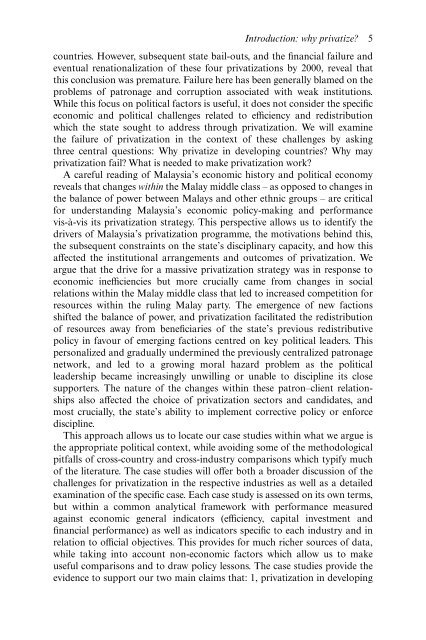PRIVATIZATION Privatization in Malaysia, Regulation, rent-seeking and policy failure
PRIVATIZATION Privatization in Malaysia, Regulation, rent-seeking and policy failure
PRIVATIZATION Privatization in Malaysia, Regulation, rent-seeking and policy failure
Create successful ePaper yourself
Turn your PDF publications into a flip-book with our unique Google optimized e-Paper software.
Introduction: why privatize? 5countries. However, subsequent state bail-outs, <strong>and</strong> the f<strong>in</strong>ancial <strong>failure</strong> <strong>and</strong>eventual renationalization of these four privatizations by 2000, reveal thatthis conclusion was premature. Failure here has been generally blamed on theproblems of patronage <strong>and</strong> corruption associated with weak <strong>in</strong>stitutions.While this focus on political factors is useful, it does not consider the specificeconomic <strong>and</strong> political challenges related to efficiency <strong>and</strong> redistributionwhich the state sought to address through privatization. We will exam<strong>in</strong>ethe <strong>failure</strong> of privatization <strong>in</strong> the context of these challenges by ask<strong>in</strong>gthree central questions: Why privatize <strong>in</strong> develop<strong>in</strong>g countries? Why mayprivatization fail? What is needed to make privatization work?A careful read<strong>in</strong>g of <strong>Malaysia</strong>’s economic history <strong>and</strong> political economyreveals that changes with<strong>in</strong> the Malay middle class – as opposed to changes <strong>in</strong>the balance of power between Malays <strong>and</strong> other ethnic groups – are criticalfor underst<strong>and</strong><strong>in</strong>g <strong>Malaysia</strong>’s economic <strong>policy</strong>-mak<strong>in</strong>g <strong>and</strong> performancevis-à-vis its privatization strategy. This perspective allows us to identify thedrivers of <strong>Malaysia</strong>’s privatization programme, the motivations beh<strong>in</strong>d this,the subsequent constra<strong>in</strong>ts on the state’s discipl<strong>in</strong>ary capacity, <strong>and</strong> how thisaffected the <strong>in</strong>stitutional arrangements <strong>and</strong> outcomes of privatization. Weargue that the drive for a massive privatization strategy was <strong>in</strong> response toeconomic <strong>in</strong>efficiencies but more crucially came from changes <strong>in</strong> socialrelations with<strong>in</strong> the Malay middle class that led to <strong>in</strong>creased competition forresources with<strong>in</strong> the rul<strong>in</strong>g Malay party. The emergence of new factionsshifted the balance of power, <strong>and</strong> privatization facilitated the redistributionof resources away from beneficiaries of the state’s previous redistributive<strong>policy</strong> <strong>in</strong> favour of emerg<strong>in</strong>g factions centred on key political leaders. Thispersonalized <strong>and</strong> gradually underm<strong>in</strong>ed the previously centralized patronagenetwork, <strong>and</strong> led to a grow<strong>in</strong>g moral hazard problem as the politicalleadership became <strong>in</strong>creas<strong>in</strong>gly unwill<strong>in</strong>g or unable to discipl<strong>in</strong>e its closesupporters. The nature of the changes with<strong>in</strong> these patron–client relationshipsalso affected the choice of privatization sectors <strong>and</strong> c<strong>and</strong>idates, <strong>and</strong>most crucially, the state’s ability to implement corrective <strong>policy</strong> or enforcediscipl<strong>in</strong>e.This approach allows us to locate our case studies with<strong>in</strong> what we argue isthe appropriate political context, while avoid<strong>in</strong>g some of the methodologicalpitfalls of cross-country <strong>and</strong> cross-<strong>in</strong>dustry comparisons which typify muchof the literature. The case studies will offer both a broader discussion of thechallenges for privatization <strong>in</strong> the respective <strong>in</strong>dustries as well as a detailedexam<strong>in</strong>ation of the specific case. Each case study is assessed on its own terms,but with<strong>in</strong> a common analytical framework with performance measuredaga<strong>in</strong>st economic general <strong>in</strong>dicators (efficiency, capital <strong>in</strong>vestment <strong>and</strong>f<strong>in</strong>ancial performance) as well as <strong>in</strong>dicators specific to each <strong>in</strong>dustry <strong>and</strong> <strong>in</strong>relation to official objectives. This provides for much richer sources of data,while tak<strong>in</strong>g <strong>in</strong>to account non-economic factors which allow us to makeuseful comparisons <strong>and</strong> to draw <strong>policy</strong> lessons. The case studies provide theevidence to support our two ma<strong>in</strong> claims that: 1, privatization <strong>in</strong> develop<strong>in</strong>g


